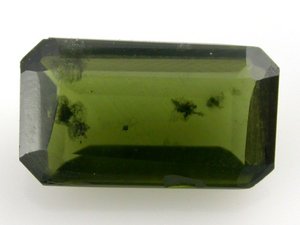| Crystal system | Amorphous |
| Transparency | Transparent to translucent |
| Luster | Vitreous |
| Fracture | Uneven |
| Cleavage | Distinct |
| Specific Gravity | 3.28 |
| Hardness | 6 to 6.5 |
| Optical Character | Uniaxial + ; Double Refractive |
| Refractive index | 1.597 |
| Birefringence | 0.012 |
| Dispersion | |
| Fluorescence | |
| Pleochroism | |
| Chemical Formula | Ca2ThSi8O20 |
| Comments | |
| Streak | White |
Ekanite (EK-ah-nite) is a complex metamict calcium thorium silicate with the formula (Th,U) (Ca,Fe,Pb)2Si8O20. It was named after F.L.D. Ekanayake, a gem dealer in Colombo, Ceylon, who discovered it in 1953. Mr. Ekanayake bought two dark-green faceted stones on the market in Colombo because they looked unlike any gem with which he was familiar. Tests he performed indicated glass, but inclusions in the stone indicated otherwise.
One specimen later examined by British scientists proved to contain calcium, lead, thorium and silicon. The species, however, was not properly identified until 1961. All samples tested have been highly radioactive, and it is apparent that ekanite is a metamint mineral similar to green, low property zircon, but one in which structural breakdown has been more complete than in zircon. Ekanite is now amorphous, but inclusions indicate that it was once tetragonal. A few pieces found in Ceylon have exhibited a four rayed star.


